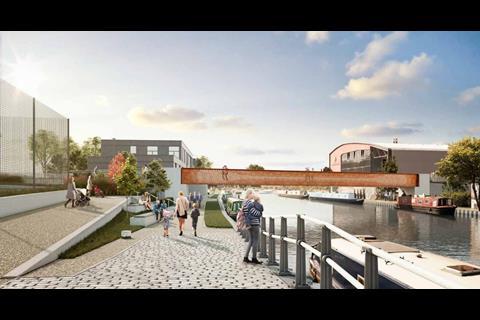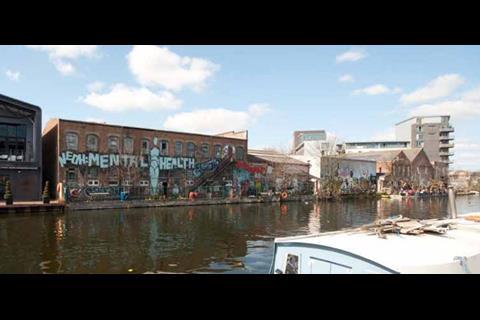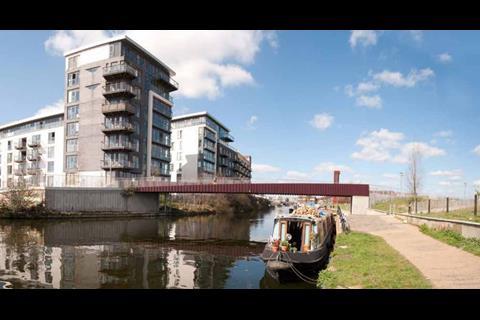Borough mayor and campaigners call for rethink as demolition looms for east London wharf building
Campaigners fighting proposals for two new bridges linking east London’s Olympic Park with the Fish Island neighbourhood in Bow have launched a last-ditch bid to halt the plans.
The new structures – one for both vehicles and pedestrians, the other for pedestrians and cyclists – were designed by Sheppard Robson and provide connections across the River Lee Navigation as part of the development of the new East Wick and Sweetwater neighbourhoods.
But the new pedestrian and cycle bridge requires the demolition of the historic but unlisted industrial building Vittoria Wharf, which housed artists and other creative-industries workers before they were moved out for its pending demolition.
The bridges plan was granted outline consent in 2012 and full permission last year. Work is set to start this year.
However campaigners have collected a petition with nearly 10,000 names calling for the proposals to be dropped, and the elected mayor of Tower Hamlets has urged London mayor Sadiq Khan to conduct a full review into the plans – rubbishing a November 2017 Transport for London study in the process.
The Save Hackney Wick campaign group argues that the new pedestrian-and-cyclist bridge is only required because the proposed road bridge will be built on the site of the area’s current non-vehicle crossing.
It says the recent TfL study showed there was a “weak” case for the bridges and that their provision flew in the face of flagship City Hall policies of protecting cultural space and promoting clean air.
Last week, Tower Hamlets mayor John Biggs and councillors representing the Fish Island neighbourhood wrote to Val Shawcross, deputy mayor of London for transport, criticising the TfL review and calling for a rethink of the bridges schemes.
Biggs said the study was “disappointing” as it did not draw on any new evidence, did not address residents’ concerns about rat-running or increased pollution and failed to demonstrate how connectivity between the east and west banks of the Lee Navigation would be improved.
“It is still possible to establish a meaningful review of connectivity in the area and we remain hopeful that the Greater London Authority, Transport for London and the London Legacy Development Corporation will reconsider these plans,” he said.
BD asked both the LLDC and City Hall for its response to Biggs’ concerns on the TfL review, but neither addressed them directly.
A spokesman for Sadiq Khan said the London mayor was “fully aware” of the concerns raised about the bridge plans, which was why he had commissioned the TfL review.
“TfL concluded that the bridges are needed to avoid future traffic congestion and any associated air pollution, but they have been asked to explore whether those transport benefits could still be secured while potentially restricting the all-modes-of-transport bridge to buses, cycling and pedestrian use only,” he said.
In relation to the loss of creative workspace that the demolition of Vittoria Wharf would entail, the spokesman said: “The mayor has been clear that developers and planners must do all they can to protect artists’ workspace, and has been assured all is being done to ensure the amount of creative workspace will remain the same in the area.”
The LLDC, which is a mayoral development corporation, said the reserved matters planning application that resulted in detailed approval being granted to the bridge proposals in March last year had been supported by an environmental impact assessment.
A spokeswoman added that the bridges would “make it much easier for local residents to access the new world-class facilities in Queen Elizabeth Olympic Park which include schools, healthcare centres and jobs”.
“The bridges will also help ease congestion as Hackney Wick and Fish Island grow to include thousands of extra homes, new business and studio space, which the existing road network will struggle to serve,” she said.
The Sweetwater and East Wick neighbourhoods are earmarked for the delivery of 1,500 new homes, the first 300 of which were granted planning permission last year.
The homes are being developed by a joint venture between Balfour Beatty Investments and the development and regeneration specialist Places for People.
The 2015 development agreement, signed between the joint venture partners and the LLDC, includes the provision of the two bridges.
Buildings by Studio Egret West, Astudio and Piercy and Co are also part of the first phase of East Wick and Sweetwater.




















No comments yet